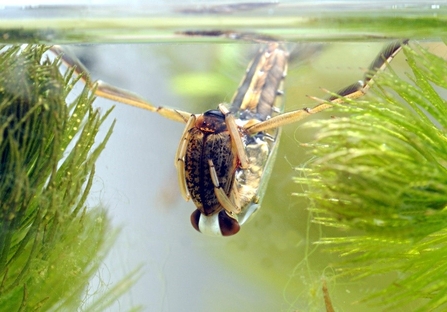
Backswimmer devouring a water beetle in a vampire embrace © Will Watson
Pirate Wolf Spider © Will Watson

Backswimmer devouring a water beetle in a vampire embrace © Will Watson
Ponds are full of weird and wonderful creatures lurking around, some of which are totally creepy...
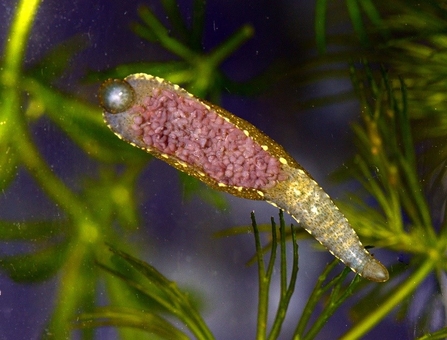
Duck leech carrying its babies © Will Watson
Did you know that there are 16 species of leech in Britain? However, only 1 of those species has the ability to suck human blood: the medicinal leech (Hirudo medicinalisi). Horrifyingly, using their 3 jaws and 100 teeth, they can consume up to 10 times their body weight at each feeding, equivalent to 5-15 ml of blood!
Medicinal leeches have suffered dramatic declines in Britain, partly because they were historically believed to be a cure for many disorders through the removal of ‘bad blood’. Leeches are, in fact, still used in modern medicine to improve blood flow and prevent blood clots, as their saliva contains anticoagulants.
Late August this year, Herefordshire Wildlife Trust ecologists and volunteers embarked on a medicinal leech survey day at Moccas Park Nature Reserve to determine if the species is present at the site. We had a very professional day, pretending to be cows and splashing around with a net in the Lawn Pool! Unfortunately, we did not find any medicinal leeches, although not all hope is lost, as we are hoping to make use of eDNA sampling to check for the presence of their DNA!
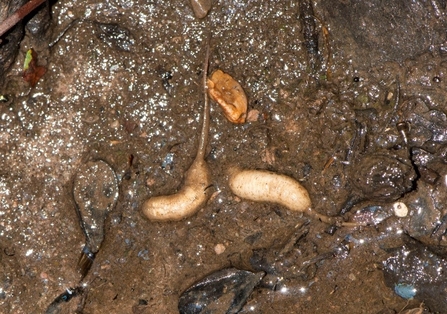
Two rat-tailed maggots © Will Watson
This is one creepy insect!
Rat-tailed maggots are the larval form of a hoverfly commonly known as a drone fly (Eristalis tenax) – a valuable plant pollinator, which looks much more attractive in its adult form. You may be disgusted to discover that as well as residing in stagnant water, they like to develop in putrid and foul-smelling conditions, including animal faeces and rotting carcasses. The species tends to feed on decaying animal or plant matter. Therefore, you are only likely to find this critter in ponds that are stagnant and highly polluted!
Moreover, the species has rarely been reported to infest humans and other vertebrate animals by accident, through the ingestion of contaminated water or uncooked food, particularly in countries with unsatisfactory sanitary conditions. Yuck! If that’s not terrifying enough then I don’t know what is.
Its most notable feature is its rat-like tail, or ‘siphon’, which can extend to about two inches, and is used as a snorkel to allow the maggot to breathe air whilst feeding.
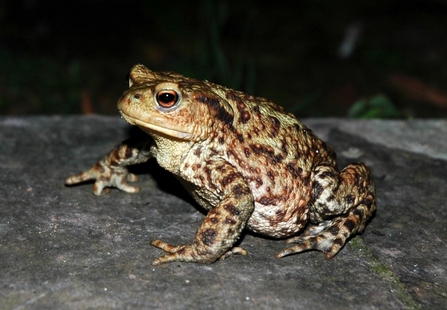
Female toad © Will Watson
‘In the cauldron boil and bake; Eye of newt and toe of frog’ – Shakespeare’s Macbeth
Okay, arguably, amphibians are not that terrifying. However, they have long been connected to ancient folklore and mythology and remain surrounded by a negative stigma. In Elizabethan England, herbalists and healers were associated with witchcraft and potion-making. To protect their livelihoods and establish secrecy, they renamed many ingredients for their herbal remedies. It was common to use names of body parts of amphibians to describe parts of plants, e.g., eyes referred to seeds, prompting their association with witchcraft.
You may be surprised to find that there are only 5 native species of amphibians in Herefordshire: the common toad, common frog, and three species of newt (great-crested, palmate and smooth). The common toad (Bufo bufo) is probably the creepiest looking amphibian to most people, possessing rough, warty skin. From medieval times, it was thought that toads were poisonous, although this is not the case in the UK. This fear arose from the fact that toads release bufotoxin from toxic glands in their warts to deter predators, which would cause sickness if ingested. Moreover, toads are renowned for their mass migrations back to breeding ponds on the first warm and damp evenings of the year, and this swarming was considered an omen of evil.
However, amphibians are a valuable part of the food chain in wetland habitats, acting as both predator and prey, and unfortunately, the loss and degradation of wetland habitat is causing 40% of species worldwide. Additionally, roads pose a significant threat to toads by obstructing migration routes.
Curiously, amphibians originally symbolised fertility, fortune and rebirth in Egyptian times. Perhaps it is time we again embrace this perspective on the fascinating nature of amphibian metamorphosis, viewing it as a magic which should be protected rather than feared.
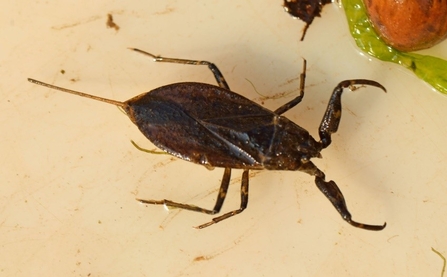
Water scorpion © Will Watson
Although the water scorpion (Nepa cinerea) is not a true scorpion, it certainly looks just as intimidating! Its sinister-looking tail is actually used as a ‘snorkel’ rather than a sting, allowing it to breathe whilst underwater. This underwater predator hides amongst dead leaves and ambushes its prey (insects, tadpoles, and small fish), catching it with pincer-like front legs. Then, the water scorpion uses its piercing mouthparts to suck the fluids from its victims!
These creepy crawlies are known as ‘toe-biters’ because they do exactly that! You may be relieved to hear that its bite is not poisonous, although you should still be careful when wading in shallow water, especially as the species is very common around the shallow edges of garden ponds.
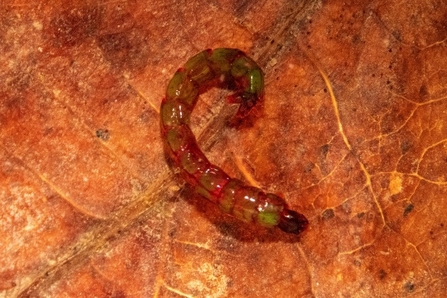
Bloodworm © Will Watson
Some of the larvae of non-biting midges (Chironomidae) are known as bloodworms. The reason for their unsettling vivid red colour is that they contain high levels of haemoglobin, allowing them to live in low oxygen environments. As they do not swim very well, they favour slower moving water in pools and ponds.
They are a useful species for water quality monitoring, due to their tolerance to pollution, including sewage effluent and farmland runoff. Moreover, they are an important food source for numerous species.
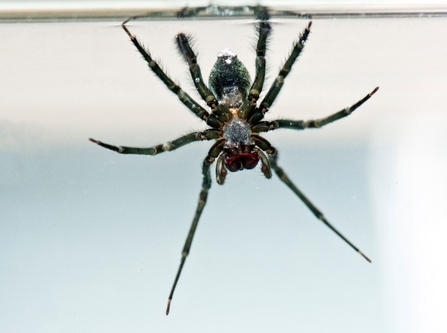
Water Spider showing off its fangs © Will Watson
Move over werewolves, there’s a new monster in town…. the pirate wolf spider (Pirata piraticus)!
This spider is a distinctive aquatic invertebrate which can run and stand on the water’s surface due to the water repellent hairs on its legs. It can be found in Herefordshire, so you might want to watch your backs this Halloween!
Although these spiders do not shapeshift on the night of a full moon, they are active hunters which chase down and ambush their prey, immobilising it with their jaws and legs. They can sense any movement of their prey through vibrations in the water’s surface. Curiously, instead of building a web, pirate wolf spiders construct a silk retreat which they use as a home, rather than for catching prey.
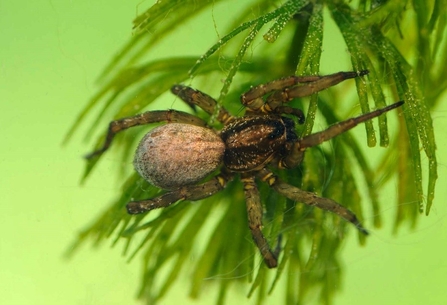
Pirate Wolf Spider © Will Watson
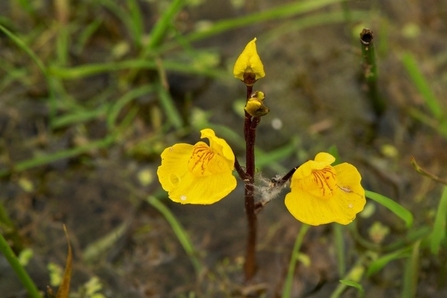
Common Bladderwort © Will Watson
Bladderwort (Utricularia australis) is a free-floating aquatic plant species with distinctive yellow flowers, which in Herefordshire, can only be found at the Moccas Park site.
You may be thinking… this plant looks quite pretty, what’s so creepy about it? It may look harmless, but bladderwort is more sinister than it seems. This is a carnivorous plant covered in tiny hollow underwater structures (bladders) which act as suction traps for small invertebrates. When an insect touches the bristles on the outside of a bladder, the trap door mechanism opens and the bladder sucks in the prey. Enzymes are secreted to digest the prey and supply the plant with nutrients. On the brighter side, this species also provides a food source and shelter for several invertebrates, mammals, and waterfowl. What a remarkable plant!
https://www.rcseng.ac.uk/library-and-publications/library/blog/why-you-should-love-a-leech/
https://www.bumblebee.org/invertebrates/ANNELIDAb1.htm
https://www.sciencedirect.com/topics/biochemistry-genetics-and-molecular-biology/leech
https://www.mirror.co.uk/news/world-news/revolting-rat-tailed-maggots-live-10703675
http://www.uksafari.com/dronefly.htm
https://entnemdept.ufl.edu/creatures/livestock/rat-tailed_maggot.htm
https://www.froglife.org/2020/10/27/halloween-folklore-and-myths/
https://www.wildlifetrusts.org/wildlife-explorer/amphibians/common-toad
https://www.wwt.org.uk/discover-wetlands/wetland-wildlife/amphibians/#
https://www.wildlifetrusts.org/wildlife-explorer/invertebrates/bugs/water-scorpion
https://www.letsgowild.co.uk/wildlife/water-scorpion/
https://river-life.org.uk/wildlife/invertebrates/midge-larvae/
https://www.naturespot.org.uk/species/pirate-wolf-spider
https://www.landscapebritain.co.uk/wildlife/pirate-wolf-spider/
https://www.spiderspotter.com/en/species/wolf-spiders/53-pirate-otter-spider
https://www.pond-life.me.uk/plants/floating/utricularia
https://www.britannica.com/plant/bladderwort
https://www.lancswt.org.uk/blog/charlotte-varela/spooky-halloween-wildlife